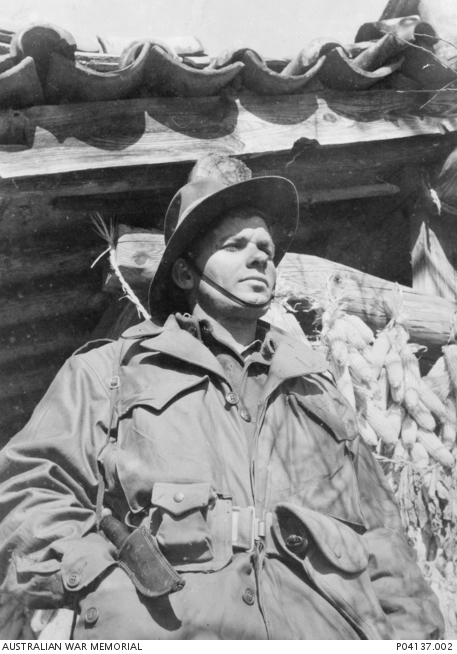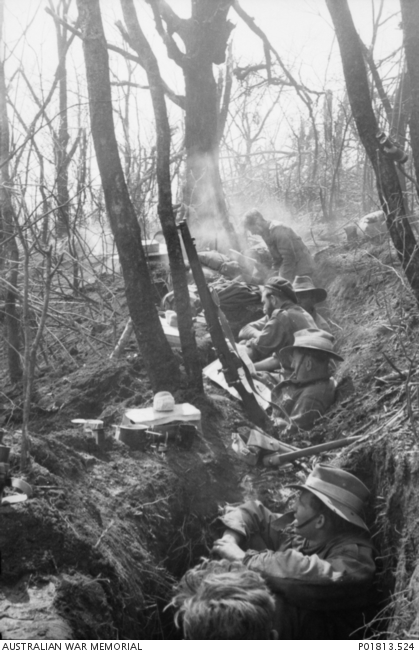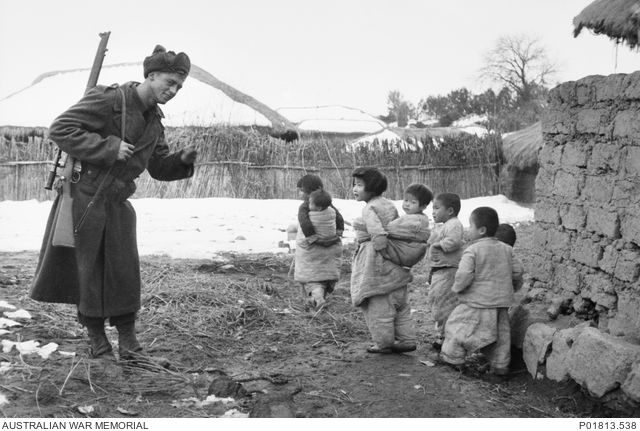Sniper first, photographer second: Ian “Robbie” Robertson
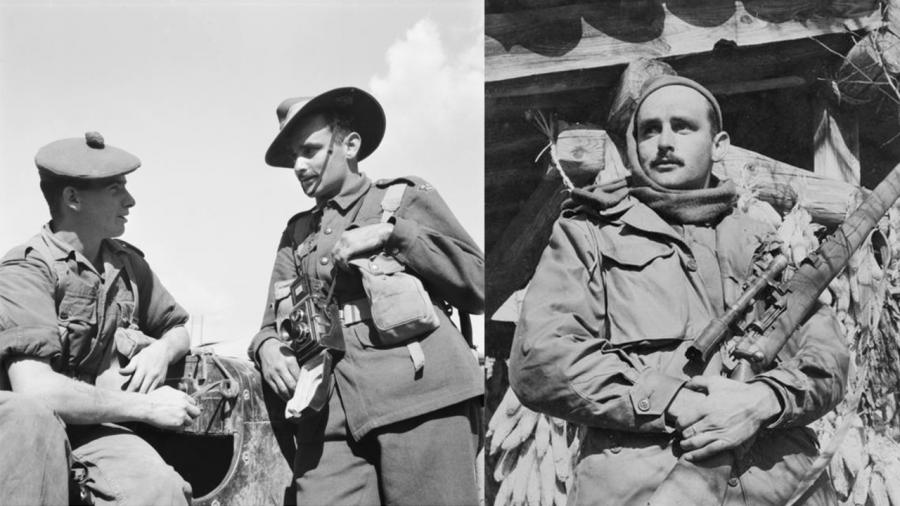
Image on left: Private Ian Robertson (right) chats with Scottish infantryman, Private D Hunter from Glasgow. Robertson’s Zeiss Ikon Ikoflex twin lens reflex camera with a 3.5 Tessa lens is hanging around his neck. HOBJ1335
Image on right: Informal portrait of Ian Robertson holding a .303 inch SMLE No.1 MkIII* (HT) rifle fitted with a 3-power Pattern 1918 (Australian) telescopic sight. The sight is a copy of the British Pattern 1918 sniper scope and was manufactured by the Australian Optical Company in Melbourne. P03732.001
Ian Robertson had an eye for photography – and sniping. He was considered to be one of the best marksmen in his unit, the 3rd Battalion, the Royal Australian Regiment (3RAR) during the Korean War. Robertson was chosen by Phillip Hobson to be his replacement as battalion photographer and was soon armed with both a rifle and a camera. Born on 21 February 1927 in Heidelberg, Victoria, Robertson was too young to serve in the Second World War, but enlisted in the Australian Army in 1945, continuing his family’s tradition of service.
Robertson’s grandfather, Ernest, had worked for the Argus as a printer and served in the Printing Section in Egypt during the First World War; his father, James, joined the 23rd Battalion at Gallipoli at the age of 15; his maternal great-uncle, Gideon Dare, served in the same battalion; his uncle Frank Leslie was killed during the Anzac Landings in 1915; and his uncle Albert served with No. 4 Squadron of the Australian Flying Corps in France and was awarded the Military Cross in 1918. Robertson’s younger uncles, Donald, Harold and Roy, served in the Second World War. Roy became a prisoner of the Japanese at the fall of Singapore in 1942. All three returned home. Robertson’s older brother Douglas served in the 2/5th Battalion at the age of 17; and his brother-in-law Allan Hargreaves served in 2/32nd Battalion.
Robertson attempted to enlist at the age of 15, but the recruiting officer knew his father and deterred him.
In 1946, Robertson became part of the British Commonwealth Occupation Force in Japan, where he met Claude Holzheimer and Phillip Hobson, official Australian Army Public Relations photographers for Japan and Korea. He also met his future wife, Miki, who he married in October 1952 in Kure. Her brother, who had served in Manchuria, gave her permission to marry Robertson, a fellow infantryman. Miki was unable to migrate to Australia until June 1953.
Informal portrait of Sergeant Claude Holzheimer, a Military History Section and Army Public Relations photographer.
Robertson shares a beer with his Japanese girlfriend (likely Miki, his future wife) in September 1950 before he left for Korea.
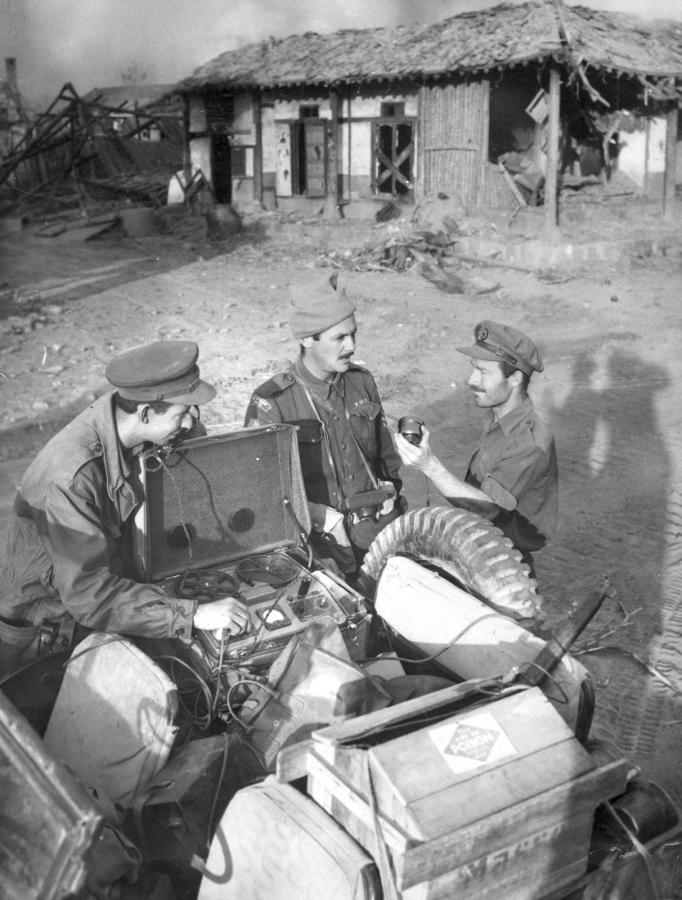
Hobson (centre) being interviewed by Ted Russell and Des Telfor from the ABC at Chongju in 1950. Arthur Gulliver. State Library of Victoria
Robertson arrived in Japan with little to no experience and a box-brownie camera, carried by most soldiers. Under Holzheimer and Hobson’s tutelage, Robertson became the battalion photographer for the Korean War. Holzheimer supplied Robertson with printing paper and took a keen interest in the younger photographer. He also married a Japanese woman, Norie Asada, in 1952. Both Norie and Miki were from Hiroshima.
Hobson and Robertson had served together in 67 Battalion. Robertson developed his photographs with the assistance of a local Japanese photographer in Hobson’s darkroom. He had three different cameras – a Mamiya, a Canon, and finally a Zeiss Ikoflex – and charged his fellow soldiers one shilling per print. Hobson recommended Robertson as his replacement as official battalion photographer when Hobson left to join Public Relations in 1949.
Robertson served with 67 Battalion until 1948 when it became 3RAR. Chosen as a sniper in late 1949, he was considered one of the top ten marksmen in 3RAR, a battalion of over 600 men. Robertson was wounded in action in late November 1950 after the battle of Yongju when his rifle jammed and a North Korean soldier’s bullet grazed his wrist; again at Chongju when he was hit by shrapnel in the leg; and a third time in April 1951 before the battle of Kapyong when he was targeted by mortars on the “Salmon” position. He returned to Korea for a short tour in March 1953 with 1RAR.
Members of the Intelligence or Sniper Section sit in a shallow trench after capturing Hill Salmon from the Chinese in April 1951. Robertson was hit by mortars and wounded on this position. Photograph taken by Robertson.
Robertson had been taught by his father and uncles to shoot rabbits on their property in Victoria and was an exceptional marksman. In November 1951 he represented the British Commonwealth Forces Korea at the King’s Medal Shoot, Williamstown. The following year he came second in the Queen’s Medal Shoot. Serving in the Sniper Section, part of the Intelligence Section within Headquarters Company, Robertson found himself serving close to his commanding officers, Lieutenant Colonels Charles Green (who died of wounds in November 1950) and Bruce Ferguson. Robertson was a sniper first, and a photographer second.
A .303 inch SMLE No.1 MkIII* (HT) rifle of the type used by Robertson in Japan and Korea.
Robertson’s photography was influenced by Hobson’s style. He certainly had an eye for photography, which was likely due to his depth perception as a sniper. Looking through a camera sight was not so different to a sniper scope. Below is a comparison of Robertson’s and Hobson’s portraiture style. Robertson’s portrait of an unidentified Australian soldier is on the left; Hobson’s is on the right. The photographs of the same subject were taken in late 1950 and 1951.
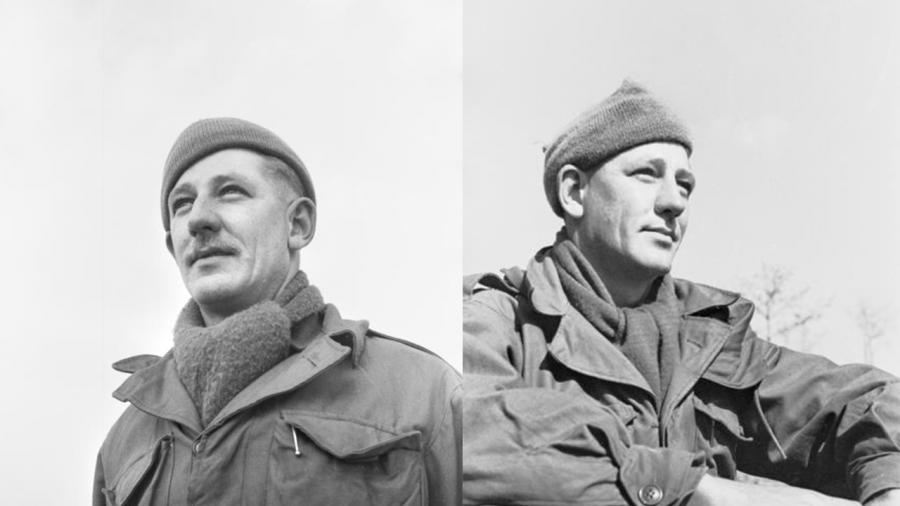
Side by side portrait comparison of an unidentified soldier from the 3rd Battalion, Royal Australian Regiment. Hobson's portrait is on the left - HOBJ1777 - and Robertson's is on the right - P01813.818.
Robertson photographed his comrades while serving side by side with them, capturing more candid imagery than the formal, staged photographs of Hobson and Holzheimer whose role was to entice Australians to enlist and show a more favourable side of the war. Holzheimer also took many photographs of the Korean people as a record for the Military History Section. Robertson took portraits, photographs of the Korean landscape, the Korean people and several 3RAR unit photos (platoons, companies and officers).
Robertson returned to Australia and had three daughters with Miki. In 1970 and 1971 he served in the Australian Army Training Team Vietnam as a warrant officer class I. He died in February 2014. Hobson served as a photographer in Malaya and as a civilian public relations photographer for the Royal Australian Navy. He died in October 2006. Holzheimer served in Vietnam in 1967 and 1968 and died in September 1969.
All three photographers had wonderfully artistic styles which capture the nuance of the Australian experience of the Korean War. The Memorial holds thousands of photographs by Hobson, Holzheimer and Robertson in the National Collection.
See a small gallery of Robertson’s photographs from Korea and Japan below:
One of the Robertson’s best known photographs shows Korean refugees carrying their possessions on their heads walking down a road.
Informal portrait of Corporal Stuart “Stewie” Ham, a member of the Sniper Section, 3RAR , shortly before he departed for service in Korea in 1950.
Hill 614 in February 1951. Two unidentified members of 3RAR kneel behind the wall of their dugout.
Members of 3RAR hitch a ride on a US Army Sherman M4A3 medium tank as it moves along the metal pontoon bridge across a river in October 1950.
South Korean civilians raise their arms and cheer on a convoy of 3RAR troops in October 1950.
Hill 614 in March 1951. Members of C Company, 3RAR led by Corporal Len Wright (left) move forward from Hill 614 to attack Hill 587. Corporal Wright was a cinema projectionist in civilian life.
Yongju, North Korea on 22 October 1950. Commander of the 27th British Commonwealth Infantry Brigade, Brigadier Aubrey Coad (left, leaning forward), Lieutenant Colonel Man of 1st Battalion, Middlesex Regiment (middle) and Lieutenant Colonel Charles Green (right) look over a map. They are discussing the battle of the Apple Orchard. The man sitting behind Green is Major Reith from 1st Battalion, the Argyll and Sutherland Highlanders, who was killed several days before Green.
Portrait of Sergeant Stafford Kenny James “Len” Lenoy, an Indigenous serviceman from the KuKu Djunkan and Butchular Nations. This portrait was taken by Ian Robertson on 19 February 1951 at Chuam-ni, South Korea. Lenoy served during the Second World War in the Aitape-Wewak campaign and transferred to 67 Battalion at the end of the war for occupation duties in Japan. The Medium Machine Gun Section Commander in A Company, 3RAR, Lenoy was killed in action during the battle of Kapyong on 24 April 1951.
January 1951. Private Chris Bell-Chambers from the Sniper Section of 3RAR smiles and waves to a group of Korean children emerging from their hiding place after their village was cleared of enemy forces.
Uijeongbu, Korea on Christmas Day 1950. Members of 3RAR are rugged up in winter gear against the extreme cold. The soldier in the centre holding the pair of gloves is Staff Sergeant Kevin Lundy, the hatless man is Sergeant Vince Bennett. The soldier on the right with his hood on is ‘Spencer’ Thomas Smith who was killed at Kapyong on 24 April 1950.
Sources:
https://www.awm.gov.au/about/our-work/publications/contact/ian-robertson
https://www.awm.gov.au/collection/C1194046
Sergeant Ian Robertson (31932) as a sniper and unit photographer 3rd Battalion The Royal Australian Regiment (3RAR), Korea 1950-51, and as a platoon sergeant 1st Battalion, interviewed by Ian Affleck on 22 May 2002. S02691
